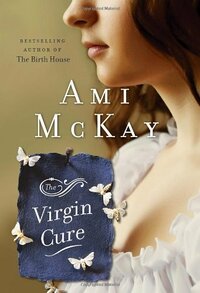You need to sign in or sign up before continuing.
Take a photo of a barcode or cover
This book should have had a different title! Although the Virgin Cure is addressed in the book, it's not what the story is about. It's about a young girl growing up in the slums of NYC in 1871 who ends at a brothel and everything that happens to her in between. It's also about the female doctor in charge of taking care of the girls who live & work in the brothel. The doctor is modeled after the author's great, great grandmother.
I liked the fake(?) newspaper articles sprinkled throughout the book and the sidebar footnotes and detailed descriptions of ladies fashion from old issues of Harper's Bazar.
A lot of reviewers complained about how the author left a lot of loose ends in the story. Somehow I missed those and wasn't bothered by it, I guess. I enjoyed the book very much. It wasn't a great piece of literature, mind you, but it held my interest. I wish I lived in New York so I could run right out and see the Tenement Museum and the site of the Stuyvesant Pear Tree and a Dime Museum and other peculiarities.
I liked the fake(?) newspaper articles sprinkled throughout the book and the sidebar footnotes and detailed descriptions of ladies fashion from old issues of Harper's Bazar.
A lot of reviewers complained about how the author left a lot of loose ends in the story. Somehow I missed those and wasn't bothered by it, I guess. I enjoyed the book very much. It wasn't a great piece of literature, mind you, but it held my interest. I wish I lived in New York so I could run right out and see the Tenement Museum and the site of the Stuyvesant Pear Tree and a Dime Museum and other peculiarities.
I understand the compulsion to include the doctor's observations and voice, but I found them distracting. Moth is a fabulous character and this is a great story
As usual, Ami McKay wows with her attention to historical detail and her ability to break your heart and then mend it, all while maintaining relative realism. This was an overall great read, and I finished it in one content sitting. I highly recommend this book and her other novel, The Birth House.
What a great tale of 1800s New York City. From the tenements of the lower east side to the Bowery to uptown this story of 12 year old Moth and the violent grown up world she is thrown into is a treat for history lovers.
I love books set in this time period- an interesting subject but not too graphic
adventurous
dark
emotional
reflective
sad
tense
fast-paced
Plot or Character Driven:
Character
Strong character development:
Yes
Loveable characters:
Yes
Diverse cast of characters:
No
Flaws of characters a main focus:
Complicated
Graphic: Adult/minor relationship, Abandonment
Absorbing, interesting and well-researched, Ami McKay's "The Virgin Cure" follows 12 year-old Moth as she moves from the slums of New York City, to a lady's maid, to a brothel house. Moth is determined, and resourceful, but still young. She receives guidance from a smart young female doctor, and uses that friendship to make decisions that will impact her future.
Ami McKay writes beautifully, and we are transported back to New York in the 1870's, where being a young, poor, woman (and making the limited choices available) was a different existence entirely.
Ami McKay writes beautifully, and we are transported back to New York in the 1870's, where being a young, poor, woman (and making the limited choices available) was a different existence entirely.
I loved Ami McKay's first book, The Birth House, so I was eager to read this one without even knowing the synopsis. This book did not really live up to the quality of the first book, but I did still enjoy it. While the title conveys the idea that the focus of the book is this social problem of the myth of the "virgin cure", in reality the book was really about the life of the main character, Moth. The virgin cure only plays a part in two small events, and serves better as a footnote to Moth's life.
Moth is quite an interesting girl from the start, having the maturity of a much older person as she deals with her mother's methods of making money along with her drinking habits, even as she finds her own ways of survival. Despite being of such a young age, she is aware of the struggles of the people around her and knows enough to recognize what a better life would look like for herself - even beyond the trappings of wealth. While sold by her own mother for the price of a sack of coins, Moth still longs to impress her and return to her. From there, she encounters one horror after another, many hidden behind a veneer of wealth and privilege. Her desires propel her to take on a different name in an effort to change her very identity into the kind of person she longs to be.
Dr. Sadie's intervention into Moth's life provides a nice contrast to what Moth lived with day-to-day. As McKay's original protagonist, she provided another appealing way of life other than one of wealth and privilege. Her journal entries in the book also showed how Moth appeared to others. Despite the struggles that Dr. Sadie endured as a female physician, I liked the part she played in Moth's life and the things she showed Moth.
As for the format of the book, I found it a bit strange sometimes. The pages often held side notes that had little to do with the plot, and were better at serving as distractions, plus chapters often began with poems or quotes that were vague at best and required some intelligent deciphering to figure out how they contributed to the book. The journal entries of Dr. Sadie that peppered the book held the most valuable writing, as it fit in with the timeline of the plot. I think the book would have fared better with less distractions, more plotting, and a better title.
Moth is quite an interesting girl from the start, having the maturity of a much older person as she deals with her mother's methods of making money along with her drinking habits, even as she finds her own ways of survival. Despite being of such a young age, she is aware of the struggles of the people around her and knows enough to recognize what a better life would look like for herself - even beyond the trappings of wealth. While sold by her own mother for the price of a sack of coins, Moth still longs to impress her and return to her. From there, she encounters one horror after another, many hidden behind a veneer of wealth and privilege. Her desires propel her to take on a different name in an effort to change her very identity into the kind of person she longs to be.
Dr. Sadie's intervention into Moth's life provides a nice contrast to what Moth lived with day-to-day. As McKay's original protagonist, she provided another appealing way of life other than one of wealth and privilege. Her journal entries in the book also showed how Moth appeared to others. Despite the struggles that Dr. Sadie endured as a female physician, I liked the part she played in Moth's life and the things she showed Moth.
As for the format of the book, I found it a bit strange sometimes. The pages often held side notes that had little to do with the plot, and were better at serving as distractions, plus chapters often began with poems or quotes that were vague at best and required some intelligent deciphering to figure out how they contributed to the book. The journal entries of Dr. Sadie that peppered the book held the most valuable writing, as it fit in with the timeline of the plot. I think the book would have fared better with less distractions, more plotting, and a better title.
I enjoyed reading this book much more than I expected to. I picked it up from a Little Free Library in my area and really had not been expecting much. But it was actually a really great read. The characters were interesting and colorful. The plot was enticing. And even though the subject matter was rather dark at times, the book itself was not morbid or overly graphic. I intend to look up other titles written by this author to read, as well. And while this book would not rate as an all time favorite of mine, it was still really good reading, and I would definitely recommend it to other historical fiction fans.
A compelling story about a young girl from the slums of 1870s New York trying to make her way in the world. I could not put the book down as I cared for Moth and felt I need to see her through her story. The format of the book, with its additional info along the side giving extra facts and even catalogue advertisements of the latest fashions gave a depth to the world that Moth lived in, though I found it hard to know the right place to pause the story to read them. Overall, I enjoyed the story and would definitely recommend it to anyone who loves historical fiction and, especially those who have read McKay's The Birth House (TW: Rape)




